
Report On the State
of the Environment In China
2 0 0 4
Fresh Water Environment
Current State
1. Water Quality of the Seven Major Rivers
Among the 412 sections of the seven major rivers under water quality monitoring in 2004, 41.8% enjoyed Grade I~III water quality, 30.3% met grade IV~V water quality and 27.9% failed to meet Grade V water quality. The overall water quality of the seven major rivers was basically similar to that of 2003. Among them, the Yangtze River and Zhujiang River enjoyed relatively good water quality; the Liaohe River, Huaihe River, Yellow River and Songhuajiang River had relatively poor water quality and the Haihe River suffered from poor water quality. Major pollutants in water were ammonia nitrogen, BOD5, permanganate index and petroleum compounds.

Water quality comparison of the seven major rivers
(Note: HaiH stands for Haihe River; LH for Liaohe River; HuaiH for Huaihe River; YR for the Yellow River; SHJ for Songhuajiang River, CHJ for Changjiang (or the Yangtze River) and ZHJ for Zhujiang River)

percentage of different water quality of the major seven rivers in 2004
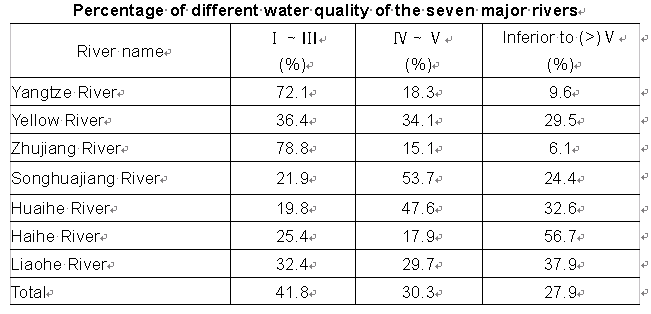
Among the 121 trans-province-boundary sections of the major seven rivers, 36.3% enjoyed grade I~III water quality, 33.9% had IV~V water quality and 29.8% failed to meet Grade V. The sections suffered from heavy pollution were those trans-province-boundary sections of Haihe River and Huaihe River systems.

Water quality percentage of trans-province-boundary sections of the seven major rivers in 2004
(1)The Yangtze River Basin
The Yangtze River system was under slight pollution. Among the 104 monitored section, the percentage of Grade I~III, Grade IV~V and that inferior to Grade V was 72.1%, 18.3% and 9.6% respectively. Major pollution indicators were petroleum, ammonia nitrogen and BOD5. No obvious change of water quality occurred compared with that of 2003.

Percentage of different water quality of the Yangtze River basin in 2004
Water quality of trans-province-boundary sections of the Yangtze River was quite good with 83.4% meeting Grade I~III water standard, 8.3% meeting Grade IV~V water quality standard and 8.3% failing to meet Grade V standard. The worst quality occurred in Chahe Section bordering Anhui Province and Jiangsu Province and Xindianpu Section on the boundary between Henan Province and Hubei Province being inferior to Grade V. Similarly, the Laochi Section on Sichuan—Chongqing boundary and Bamiaogou Section on Gansu—Sichuan boundary had Grade IV water quality. All the other 20 trans-province-boundary sections met Grade III or higher water standard.
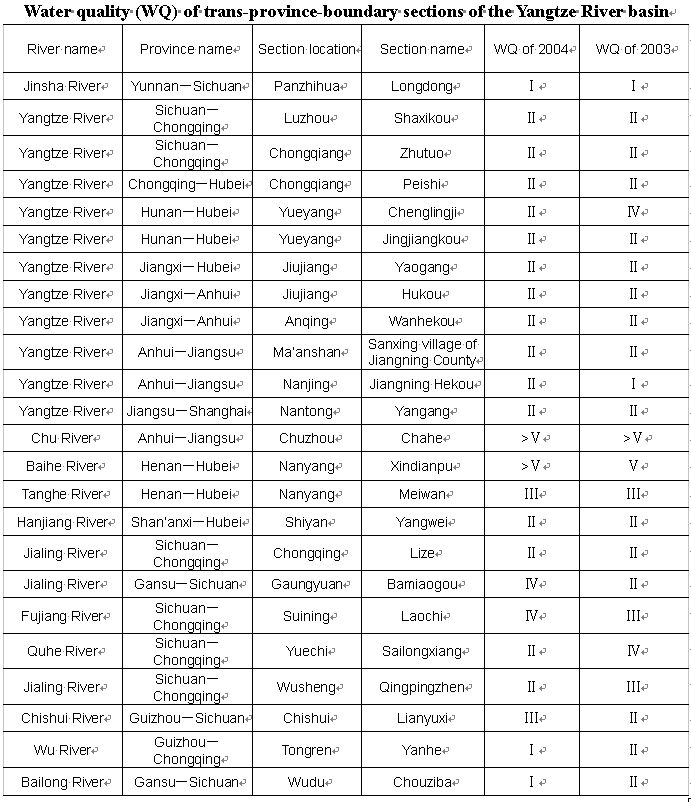
(2)The Yellow River Basin
The Yellow River was subject to intermediate pollution. Among the 44 sections under monitoring, the percentage with Grade I~III, Grade IV~V and inferior to Grade V water quality standard was 36.4%, 34.1% and 29.5% respectively. The main pollution indicators were petroleum, ammonia nitrogen and permanganate index. There was no obvious change of water quality compared with that of 2003.

Percentage of different water quality of the Yellow River basin in 2004
The water quality of trans-province-boundary sections of the Yellow River was relatively poor. Among 14 such sections, 21.4% enjoyed Grade I~III water quality, 42.9% met Grade IV~V water quality standard and 35.7% suffered from water quality inferior to Grade V. The sections such as Zhongweixiaheyan Section at Gansu—Ningxia border, Lasengmiao Section at Ningxia—Inner Mongolia, Hejin Bridge Section at Shanxi—Shaan'xi Border, Tongguan Suspension Bridge Section at Shaan'xi—Henan Border and Runcheng Section at Shanxi—Henan border had the worst water quality that was inferior to Grade V. Liuzhuang Section at Henan—Shandong border and Minhe Bridge Section at Qinghai—Gansu border had Grade V water quality. However, the water quality of other trans-province-boundary sections of the Yellow River was at Grade IV or better.
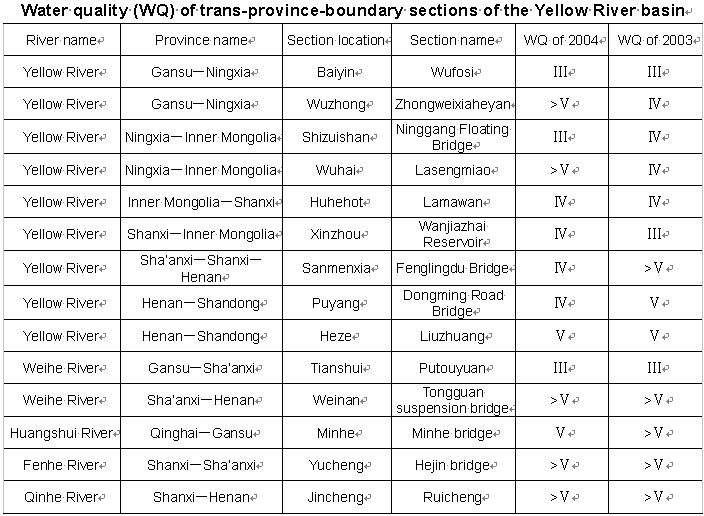
(3)Zhujiang River Basin
The overall water quality of Zhujiang River basin was quite good. Among 33 sections under monitoring, 78.8% enjoyed Grade I~III water quality, 15.1% met Grade IV~V water quality standard and 6.1% failed to meet Grade V water quality standard. Major pollution indicators were petroleum, BOD5
and ammonia nitrogen. The water quality was basically similar to that of 2003.

Percentage of different water quality of the Zhujiang River basin in 2004
Trans-province-boundary sections of Zhujiang River enjoyed relatively good water quality and 100% of them met Grade I~III water quality standard.
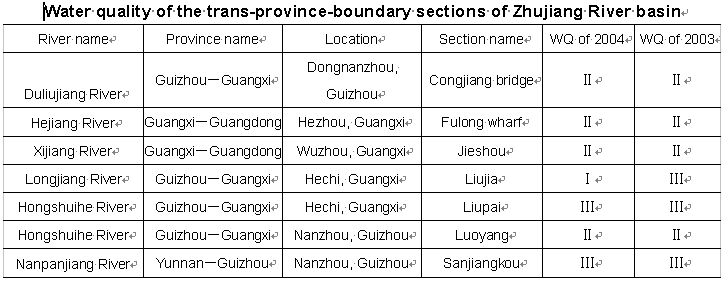
(4)Songhuajiang River Basin
Waters of Songhuajiang River was under intermediate pollution. Among the 41 sections under monitoring, the percentage that met Grade I~III, Grade IV~V or failed to meet Grade V was 21.9%, 53.7% and 24.4% respectively. Major pollution indicators were permanganate index, petroleum and BOD5. In general, the overall water quality was poor than that of 2003.

Percentage of different water quality of the Songhuajiang River basin in 2004
The water quality of trans-province-boundary sections of Songhuajiang River basin was atgeneral level. Among them, 40.0% enjoyed Grade I~III water quality, 60.0% met IV water quality standard, there was not any sections at or inferior to Grade V water quality standard.
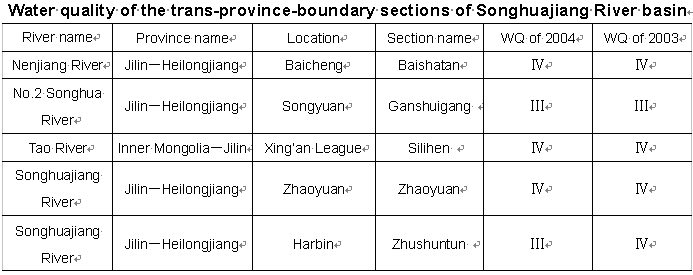
(5)Huaihe River Basin
Huaihe River basin was under intermediate level pollution. Among 86 sections under monitoring, 19.8% enjoyed Grade I~III water quality standard, 47.6% met Grade IV~V water quality standard and 32.6% failed to meet Grade V water quality standard. Major pollution indicators were petroleum, BOD5, permanganate index and ammonia nitrogen. There was not any obvious change in water quality compared with that of 2003.
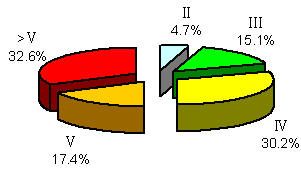
Percentage of different water quality of the Huaihe River basin in 2004
The water quality of trans-province-boundary sections of Huaihe River basin was quite poor with 8.1% meeting Grade I~III water quality standard, 51.4% meeting Grade IV~V standard and 40.5% inferior to Grade V standard.
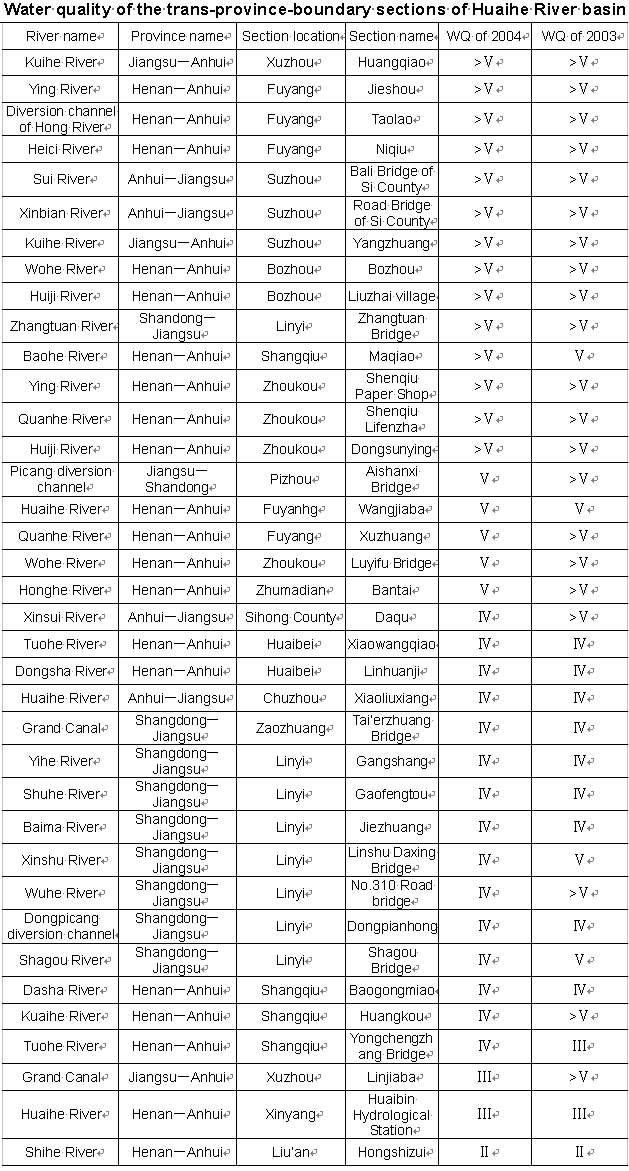
(6)Haihe River Basin
Haihe River suffered from heavy pollution. Among 67 sections under monitoring, the percentage with Grade I~III, Grade IV~V and inferior to Grade V water quality was 25.4%, 17.9% and 56.7% respectively. The major pollution indicators were permanganate index, BOD5
and petroleum. There was not any obvious change in overall water quality compared with that of 2003.
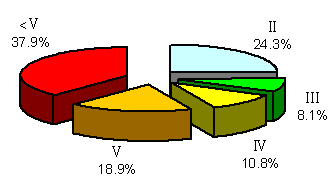
Percentage of different water quality of the Haihe River basin in 2004
The trans-province-boundary sections of Haihe River were subject to heavy pollution with 27.6% meeting Grade I~III water quality standard, 24.1% meeting Grade IV~V standard and 48.3% failed to meet Grade V standard.

(7)Liaohe River Basin
Liaohe River waters were under intermediate pollution. Among 37 sections under monitoring, 32.4% enjoyed Grade I~III water quality standard, 29.7% met Grade IV~V standard and 37.9% failed to meet Grade V standard. Major pollution indicators were BOD5, permanganate index and petroleum. The overall water quality was better than with that of 2003.

Percentage of different water quality of the Liaohe River basin in 2004
Water quality of trans-province-boundary sections of Liaohe River was relatively poor. Among those sections, the percentage with Grade III, Grade IV~V and inferior to Grade V was 20.0%, 60.0% and 20.0% respectively. There were no sections with Grade I~II quality. The section with the worst water quality occurred at Jinbaotun Section at Jilin—Inner Mongolia border, which was inferior to Grade V. Fudedian Section at Jilin, Inner Mongolia—Liaoning border and Erdaohezi Section at Inner Mongolia—Liaoning border met Grade V water quality standard. Sishuang Bridge Section at Jilin—Liaoning border met Grade IV standard. The water quality of Dianzi Section at Liaoning—Inner Mongolia border met Grade III standard.
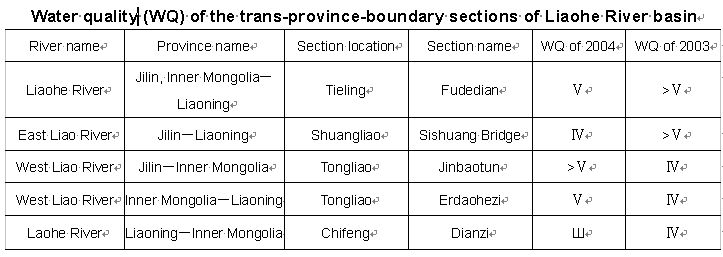
2.Water Quality of Rivers in Zhejiang Province and Fujian Province
Rivers in Zhejiang Province and Fujian Province had slight pollution. Among 31 sections of 19 rivers, 11 enjoyed Grade II water quality, accounting for 35.5%; 10 met Grade III standard, accounting for 32.3%; 7 met Grade IV standard, accounting for 22.6%; 2 met Grade V standard, accounting for 6.4% and 1 failed to meet Grade V standard, accounting for 3.2%. Major pollution indicator was petroleum.
3.Water Quality of the Rivers in Southwestern China and In-land Rivers
Water quality of southwestern part of China remained good. Among 17 sections of 10 rivers under monitoring, 2 sections enjoyed Grade I quality standard, accounting for 11.8%; 11 met Grade II water quality standard, accounting for 64.6%; 1 met Grade III quality standard, accounting for 5.9%; 1 met Grade V quality standard, accounting for 5.9%; the remaining 2 failed to meet Grade V quality standard, making up 11.8%. Major pollution indicators were lead, permanagate index and BOD5.
Inland rivers maintained good water quality. Among 28 sections under monitoring, 7 met Grade I water quality standard, making up 25%; 11 met Grade II standard, accounting for 39.3%; 7 met Grade III quality standard, accounting for 25.0%; 3 met Grade IV quality standard, making up 10.7%. There was not any section inferior to Grade IV quality standard. Major pollution indicator is petroleum.
4.Water Quality of Lakes and Reservoirs
Among 27 major lakes and reservoirs under monitoring in 2004, 2 met Grade II water quality standard, accounting for 7.5%; 5 met Grade III quality standard, making up 18.5%; 4 met Grade IV quality standard, accounting for 14.8%; 6 met Grade V quality standard, accounting for 22.2%; 10 failed to meet Grade V quality standard, accounting for 37.0%. Among those key lakes, the "Three Lakes" (Taihu Lake, Chaohu Lake and Dianchi Lake) failed to meet Grade V water quality standard. The main pollution indicators are total nitrogen (TN) and total phosphorus (TP).
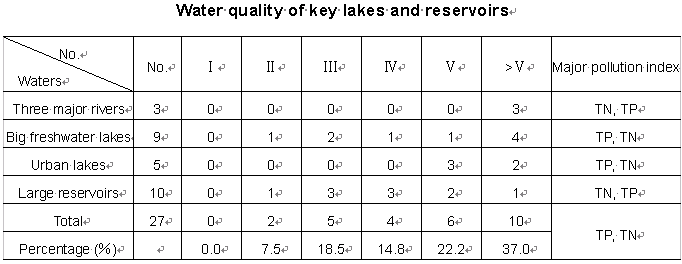
(1)Taihu Lake
There were 109 monitoring points under national water quality monitoring program in 2004, among them, 21 were in Taihu Lake and 88 in rivers surrounding the Lake.
Taihu Lake: The permanganate index of water body of Taihu Lake in 2004 met Grade III quality standard. TP met Grade IV standard. However, the water quality of Taihu Lake failed to meet Grade V quality standard due to heavy hitrogen pollution.

Among the 21 monitoring points, the percentage meeting Grade IV, Grade V and failing to meet Grade V water quality standard was 19.0%, 23.9% and 57.1% respectively. There were no such points meeting Grade I~III standard. Major pollution indicators were TN. The pollution of Wuli Lake and Meiliang Lake of Taihu water system was obviously heavier than that of the central part and eastern near-bank waters of Taihu Lake. The average nutrition index of the entire lake was 61.4, which indicates intermediate eutrophication status.
If we analyze the percentage of different water quality of the monitored points, it could be said that water quality of Taihu Lake was better than that of 2003. Because the percentage of waters failing to meet Grade V water quality standard reduced by 14.3 percentage points. The nutrition index of the lake had certain increase in terms of eutrophication analysis.

Percentage of different water quality of Taihu Lake

Comparison of the percentage of different water quality of Taihu Lake in 2003 and 2004

Rivers Surrounding the Lake Rivers surrounding Taihu Lake were subject to heavy pollution with major pollution indicators being ammonia nitrogen, total phosphorus and BOD5. Among 88 sections under monitoring, 54.5% met Grade I~III standard for permanganate index. As for the overall water quality assessment, 1.1% of these sections met Grade II quality, 12.6% met Grade III standard, 28.4% met Grade IV standard, 15.9% met Grade V standard and 42.0% failed to meet Grade V standard. There was not any obvious change of the water quality of the rivers surrounding Taihu Lake compared with that of 2003.
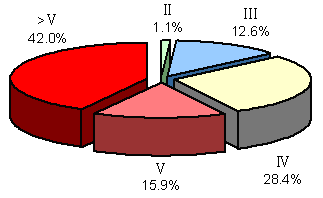
Percentage of different water quality of rivers surrounding Taihu Lake
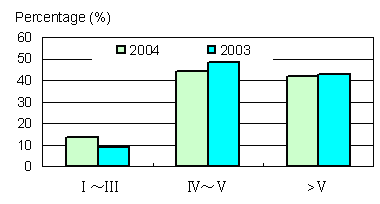
Comparison of the percentage of different water quality of rivers surrounding Taihu Lake in 2003 and 2004
(2)Dianchi Lake
Lake Body Dianchi Lake was under severe pollution. Among the waters of Dianchi Lake, Caohai suffered more contamination than Waihai. The permanganate index of Waihai met Grade III water quality standard. Nutrition study findings show that Caihai was under heavy eutrophication and Waihai was under intermediate eutrophication.
There was no big change in the concentration of each major pollutant in Caihai of the Tianchi Lake compared with that of 2003. Waihai had improved its water quality from inferior to Grade V to meeting Grade V quality standard.
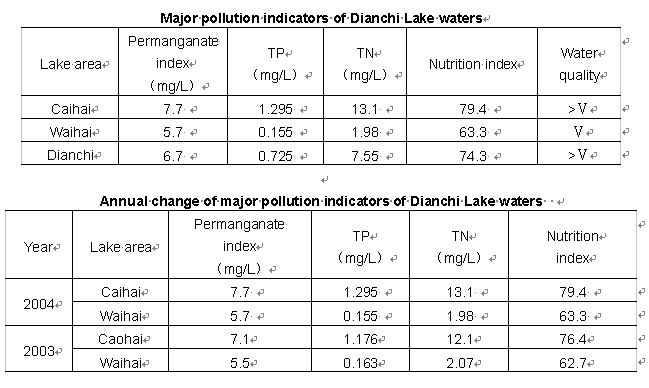
River Surrounding the Lake Among 8 monitored sections of the rivers surrounding the Dianchi Lake, 2 met Grade III water quality standard, accounting for 25.0%; 1 met Grade IV quality standard, accounting for 12.5%; 1 met Grade V quality standard, making up 12.5%; 4 failed to meet Grade V quality standard, making up 50.0%. Major pollution indicators were ammonia nitrogen and BOD5. In general, there was not any significant change in water quality of the rivers surrounding Dianchi Lake compared with that of the previous year.

Percentage of different water quality of rivers surrounding Dianchi Lake
(3) Chaohu Lake
Lake Body Permanganate index met Grade III water quality standard while the concentration of total nitrogen and total phosphorus were severely in excess of relevant standard. The water of this lake was inferior to Grade V water quality. The pollution of the western part of Chaohu Lake was obviously heavier than in eastern part of the lake. Eutrophication analysis indicated that the western part of Chaohu Lake was under intermediate eutrophication while the eastern part of the lake was under slight eutrophication. On the average, Chaohu Lake was under intermediate eutrophication. In general, no obvious change occurred in the water quality of Chaohu Lake compared with that of the previous year.

Rivers surrounding the lake Among 12 sections of the rivers surrounding the lake (including 2 sections monitoring the control of the inflow of pollutants), 1 section met Grade III water quality standard, accounting for 8.3%, 5 sections met Grade IV standard, making up 41.7%; 6 sections met Grade V standard, accounting for 50.0%. Major pollution indicators were ammonia nitrogen. There was no evident change in water quality of the rivers surrounding the lake compared with that of 2003.
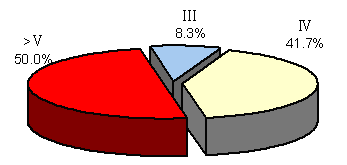
Percentage of different water quality of rivers surrounding Chaohu Lake
(4) Other Large Fresh Water Lakes and Reservoirs
Among 9 large fresh water lakes and reservoirs in mainland China, Xingkai Lake met Grade II water quality standard. Erhai Lake and Bositeng Lake met Grade III standard. The water quality of Jingbo Lake met Grade IV standard and that of Dongting Lake Grade V. Whereas Fanyang Lake, Dalai Lake, Hongze Lake and Nansi Lake failed to meet Grade V water quality standard. Major pollution indicators of each lake were total nitrogen (TN), total phosphorus (TP) and permanganate index.
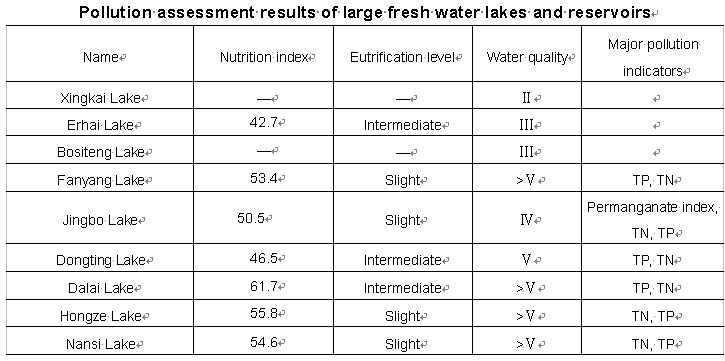
(5)Urban Lakes
Among 5 urban lakes under monitoring, Kunming Lake, the West Lake and Xuanwu Lake met Grade V water quality standard, but East Lake and Daming Lake failed to meet Grade V standard. Major pollution indicators were total nitrogen and total phosphorus. Eutrophication assessment indicated that Kunming Lake and the West Lake were under slight eutrophication whereas Quanwu Lake, East Lake and Daming Lake were under intermediate
eutrophication.
Compared with that of last year, the water quality of Kunming Lake and West Lake degraded from Grade IV to Grade V, while the water quality of the other 3 urban lakes did not have any evident change.

(6)Large Reservoirs
Among the 10 large reservoirs under monitoring in 2004, Shimen Reservoir met Grade II water quality standard. Miyun Reservoir, Qiandao Lake and Dongpu Reservoir met Grade III standard. Yuqiao Reservoir, Danjiangkou Reservoir and Songhua Lake met Grade IV standard. Dahuofang Reservoir and Laoshan Reservoir met Grade V standard. But Menlou Reservoir failed to meet Grade V water quality standard. Major pollution indicator was total nitrogen.
Eutrophication assessment indicated that large reservoirs did not suffer from heavy eutrophication. Among the nine reservoirs with complete data (Shimen Reservoir did not have complete data), Qiandaohu was under slight eutrophication, while others were under intermediate eutrophication.
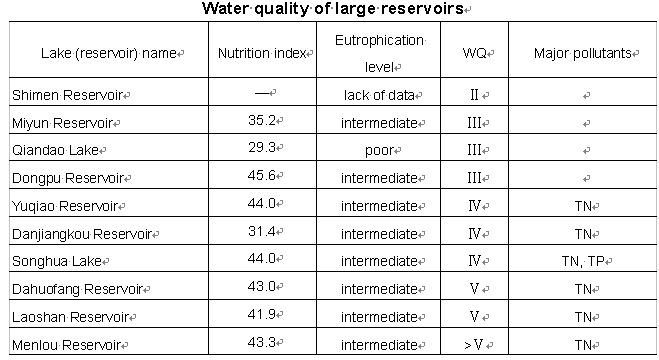
5.Water quality of drinking water sources
Among the 47 key cities on environmental protection, 25 had up-to-standard rate of 100%, 8 had up-to-standard rate of 99.9%~80%, 3 had up-to-standard rate of 79.9%~60%, 10 had up-to-standard rate of 59.9%~0.1% and 1 had the up-to-standard rate of 0% in the water quality of drinking water sources. The up-to-standard rate of water quality of drinking water sources in cities had a slight increase compared with that of the previous year.

Comparison of the up-to-standard rate of water quality of the centralized drinking water sources of key cities on environmental protection
6.Groundwater
Groundwater Quality In 2004, among 187 cities in mainland China, 39 had less pollution, 52 had more pollution and 96 remained the same pollution in groundwater compared with that of 2003. In general, groundwater quality of major cities and regions of China was subject to the impacts of human activities. As a result, the concentration of such contaminants as nitrate, nitrite, ammonia nitrogen and chlorides generally rose.
Northeastern Part of China The quality of groundwater quality of most regions basically remained the same with aggravated pollution in some cities. The concentration of some pollutants under monitoring had a slight increase. The groundwater quality of such cities as Harbin, Songyuan, Tonghua, Baishan, Dandong, Anshan, Fushun, Yingkou and Chaoyang had some improvement. But groundwater quality of Liaoyuan, Baicheng, Benxi, Liaoyang and Tieling showed degradation trend. Major pollution indicators were total hardness, mineral content, nitrates, nitrites, ammonia nitrogen and sulfates.
Northern Part of China In general, groundwater quality of this region was relatively poor showing a worsening trend. Water pollution in shallow aquifers of central Beijing, Handan, Shijiazhuang, Baodingt, Yuncheng, Wuhai and Ordos aggravated. But groundwater pollution in such areas as Langfang, Qinhuangdao, Chifeng and Jining had a reduction.
Northwestern Part of China Generally speaking, groundwater quality in this region was rather good. Pollutants under monitoring basically did not exceed relevant standard or quite low if any. Groundwater pollution of such cities as Xi'an, Urumqi, Miquan, Shihezi, Kuerle、Xifeng and Tianshui lessened. However, groundwater pollution in such cities as Lanzhou, Zhangye, Wuwei, Jinchang, Yinchuan, Dawukou, Hutubi and Wusu became worse. Major pollutants include total hardness, sulphates, sulphites, nitrites, chlorides, fluoride, iron and manganese.
Eastern Part of China In general, groundwater quality of eastern part of China basically remained at the same level compared with that of 2003. However, aggravated pollution occurred in such cities as Yantai, Rizhao, Liucheng, Binzhou, Heze, Wenzhou, Dongshan, Putian, Longyan, Huai'an, Nanchang, Ganzhou and Jingdezhen. Major pollutants included total hardness, mineral concentration, sulfates and nitrates, but the margin in excess of the standard was not big. Cities such as Tai'an, Laiwu and Zhangzhou had a cut down in groundwater pollution.
Central South and Southern Part of China In general, the overall quality of the groundwater of this region was stable. Areas such as part of Henan Province, Changsha, Guangzhou, Chenjiang, Maoming, Nanning and Guilin had reduced pollution. Whereas cities like Shangqiu, Kaifeng, Zhoukou, Huangshi, Daye and Xiaogan had aggravated groundwater pollution. Major pollutants were iron, manganese, sulfides and nitrites. But in most cases, the pollutants were within the discharge standards.
Southwestern Part of China In general, groundwater quality of this region was stable with the trend of decreased pollution. However, some cities had a worsening trend in groundwater pollution. Such cities included Kunming, Chuxiong, Zunyi and Deyang with major pollutants such as ammonia nitrogen, iron and manganese. Among them, Zunyi had the heaviest pollution with rather high concentrations of nitrites, ammonia nitrogen, fluoride, phenol and manganese. However, such cities as Anshun, Liupanshui, Guiyang, Chengdu plain, Lasa and Rigaze City had reduced pollution in groundwater. The groundwater quality of other cities remained the same compared with that of 2003.
Groundwater Table Among the 192 key cities of mainland China in 2004, 53 cities showed an increase trend in groundwater table (rise margin > 0.5 m); 61 presented down trend in groundwater table (downward margin > 0.5 m). While 78 cities basically remained the same groundwater table (fluctuation > 0.5 m) compared with that of 2003. Generally speaking, the fluctuations of groundwater table were less than 3 m with some local areas occurring with over 5 m. The worst situation occurred in eastern part of China with fluctuations in groundwater table as big as 10 ~ 40 m.
Northeastern Part of China The exploitation of groundwater was mainly concentrated in Northeast Plain and Liaodong Peninsula. The groundwater table of such cities as Changchun, Shenyang, Dalian, Benxi and Fushun showed a rising trend with rise range less than 2 m. While such cities as Yanji, Panjin, Yingkou and Chaoyang had a decreasing trend in groundwater table with the downward fluctuation about 1 m.
Northern Part of China Northern part of China is the region where groundwater is under most intense exploitation in China. As a result, the overall groundwater table is on decreasing trend due to long-term excessive exploitation with exceptions in some local area. The groundwater table of Langfang, Handan, Baoding and Hengshui in Hebei Province had a slight drop within 1 m compared with that of 2003. Shijiazhuang, Qinhuangdao and Tangshan kept similar groundwater table. But Cangzhou region had a remarkable rise of up to 7.34 m in groundwater table. The decline of groundwater table in urban areas of Beijing and Tianjin, Yuncheng of Shanxi Province, Huhehot and Baotou in Inner Mongolia was between 0.5~1.5 meter. While the groundwater level of such areas of Beijing outskirts and Taiyuan, Changzhi and Linfen of Shanxi Province rose by about 1 m.
Northwestern Part of China The change of groundwater table of this region was not even. In general, groundwater level of Shaan'xi Province was on the rise. Cities like Xi'an and Xianyang had over 3 m increase of groundwater table. But Xijiang and Gansu Province had a reduction in their groundwater table with over 2 m drop in cities like Kuitun, Dushanzi, Hutubi and Shihezi. The groundwater table of Ningxia did not have any big change. In Qinghai Province, groundwater table rose in some region but declined in other areas. Xining City had a rise of 1.25~4.91 m in groundwater table , while Golmud City had a fall of 0.85~1.17 m.
Eastern Part of China The groundwater table of Shandong and Jiangsu provinces rose in general with rising range basically less than 3 m. The overall groundwater table of Zhejiang, Anhui and Jiangxi Province dropped with the range usually less than 2 m. Shanghai and Fujian Province basically remained the same groundwater level compared with that of 2003.
Central South and Southern Part of China The groundwater level of this region had some reduction with local rise, indicating the increase of exploitation of groundwater resources. Hubei, Hunan, Guangdong and Guangxi provinces had a slight drop in groundwater table with fluctuation usually less than 1 m. Most areas of Hainan Province witnessed falling level of groundwater with downward range of 0.5~2.0 m. However, Henan Province experienced a rising trend of groundwater table with the range of 2~3 m and up to 5 m in some area.
Southwestern Part of China Groundwater resources of this region was under low level of exploitation. The overall change trend of groundwater table remained stable with increase in considerable amount of area and reduction in other cities with fluctuation less than 1 m. Among them, such cities as Guiyang, Anshun and Jinghong had over 2 m rise in groundwater table with maximum of 4.36 m. Whereas the city with over 2 m decline was Qujing of Yunnan Province with maximum fluctuation of 3.55 m.
Discharged Amount of Wastewater and Major Pollutants
Total amount of discharged wastewater in 2004 was 48.24 billion tons, of which the discharged industrial effluent was 22.11 billion tons and domestic sewage 26.13 billion tons. The discharged amount of COD was 13.392 million tons, of which the amount of industrial COD was 5.097 million tons and domestic COD 8.295 million tons. The discharged amount of ammonia nitrogen was 1.33 million tons, of which 422,000 tons were from industries and 908,000 tons from domestic source.
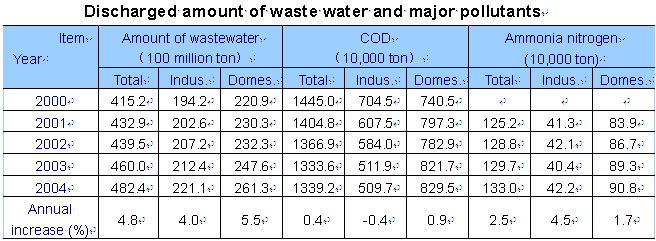
In 2004, 90.7% of the discharged industrial effluent met discharging standard, 1.5 percentage points higher than that of 2003. Among them, 91.9% of major enterprises met effluent discharging standard, 1.4 percent points more than that of 2003. In the order of 80.6% of non-major enterprises met industrial effluent discharging standard, 2.9 percentage points up than that of the previous year.
Countermeasures and Actions
【On-the-spot meeting on water pollution prevention and control of key national river basins】
This meeting was held in Wuxi City, Jiangsu Province on May 9, 2004. Vice Premier Zeng Peiyan, a Member of Political Bureau of the Central Committee of the CPC, attended the meeting and delivered an important speech. Participants included leaders from the
NPC's Environment and Resources Protection Committee, Population, Resources and Environment Committee of CPPCC, General Office of the State Council and other departments as well as those from provincial and municipal governments within key river basins attended the meeting. This meeting calls for implementing the
'Three Represents' in an all-around way and national guidelines and policies on environmental protection and adopting the
"concept of scientific development" to guide the activities of water pollution prevention and control.
【On-the-spot meeting on water pollution prevention and control of Huaihe River basin】
This meeting was held in Bengbu City, Anhui Province on October 22, 2004. Vice Premier Zeng Peiyan, a Member of Political Bureau of the Central Committee of the CPC, attended the meeting and made an important address, other participants included leaders from the
NPC's Environment and Resources Protection Committee, CPPCC's Population, Resources and Environment Committee, General Office of the State Council and other departments as well as those from provincial and municipal governments in Huaihe River basins. Leader from the governments of four provinces along Huaihe River briefed the development of the prevention and control of water pollution in Huaihe River basin. State Environmental Protection Administration, authorized by the State Council, signed Target-oriented Responsibility Contract on Water Pollution Prevention and Control in Huaihe River Basin with the governments of those four provinces.
【Development of water pollution prevention and control activities in key river basins】 In 2004, the objective of reducing chemical oxygen demand (COD) in key river basins was accomplished only by 33% on the average. However, the objective of reducing permanganate index and total phosphorus in Taihu Lake, Chaohu Lake, and Dianchi Lake basins was basically achieved. 40% of major river basin projects listed in the
Tenth Five-Year Plan for the Prevention and Control of Water Pollution in Key River Basins had been completed by the end of 2004, 8 percentage points higher than that of the previous year; 25% of those projects did not started, 20 percentage points lower than last year; and 42% of them fulfilled their investment plan, 16 percentage points higher than that of 2003.
【Up-to-standard situation of the water quality of key river basins】 Of the 111 sections under monitoring in Huaihe River basins, 34 met water quality standards as stipulated in The
10th Five-Year Plan on the Prevention and Control of Water Pollution, 31 out of 65 sections in Haihe River basins and 12 out of 37 sections in Liaohe River basins met such standards. Permanganate index and total phosphorus level of five major lake areas of Taihu Lake reached the standards,
with 16 out of 28 sections at the inflow and outflow rivers met water standard. 12 out of 21 sections at the inflow and outflow rivers of Chaohu Lake met water quality standard. The permanganate index of Dianchi Lake basically reached the standard. The water quality of the sections of the Three Gorges Reservoir area, mainstream of the upper reaches of the Yangtze River, and the sections of mainstream of tributary rivers such as Jinsha River, Wu River, Min River,
Jialing River and Chishui River met water quality standard. And 15 out of 49 sections along South-North Water Diversion Project also met the standard.
【The third test for water and sediment regulation of the Yellow River】 In 2004, the third test for water and sediment regulation of the Yellow River, which lasted 25 days, was carried out with the main site on the Xiaolangdi Reservoir covering nearly 2,000 km of river sections from Wanjiazhai Reservoir to the Yellow River estuary in Shandong Province. It was the first time that artificial means has been employed to remove the sediments, which is also the first trial in the history of world water conservancy.
Fresh Water Environment